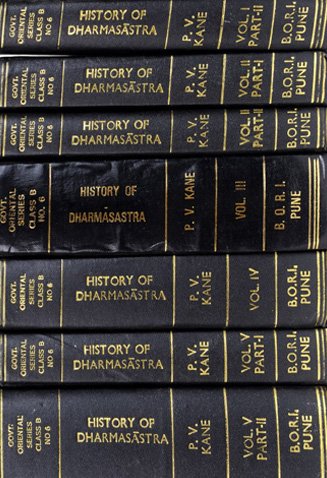Parakriti, Parakṛti, Para-kriti: 5 definitions
Introduction:
Parakriti means something in Hinduism, Sanskrit. If you want to know the exact meaning, history, etymology or English translation of this term then check out the descriptions on this page. Add your comment or reference to a book if you want to contribute to this summary article.
The Sanskrit term Parakṛti can be transliterated into English as Parakrti or Parakriti, using the IAST transliteration scheme (?).
In Hinduism
Dharmashastra (religious law)
Source: Sacred Texts: The Grihya Sutras, Part 2 (SBE30)Parakṛti (परकृति) refers to “stories”, as found in the Brāhmaṇas, according to the Āpastamba-yajña-paribhāṣā-sūtras.—“the name Veda belongs both to the Mantras and Brāhmaṇas. The Brāhmaṇas are the precepts for the sacrifice. The rest of the Brāhmaṇa, that which does not contain precepts, consists of explanations, i.e. reproof, praise, stories [viz., Parakṛti], and traditions”.
Commentary: It is difficult to find words corresponding to technical terms in Sanskrit. Arthavāda, which I have translated by explanation, means not only the telling of the meaning, but likewise the telling of the object; parakṛti, story, means literally the action of another; purākalpa, traditions, means the former state. The difference between the two is stated to be that parakṛti refers to the act of one person, purākalpa to that of several. This subject is fully treated in the Pūrva-mīmāṃsā. Satyavrata begins a new Sūtra with “reproof” (nindā).

Dharmashastra (धर्मशास्त्र, dharmaśāstra) contains the instructions (shastra) regarding religious conduct of livelihood (dharma), ceremonies, jurisprudence (study of law) and more. It is categorized as smriti, an important and authoritative selection of books dealing with the Hindu lifestyle.
Languages of India and abroad
Sanskrit dictionary
Source: DDSA: The practical Sanskrit-English dictionaryParakṛti (परकृति).—an example or precedent, a passage descriptive of the doings of men; MS.6.7.26.
Derivable forms: parakṛtiḥ (परकृतिः).
Parakṛti is a Sanskrit compound consisting of the terms para and kṛti (कृति).
Source: Cologne Digital Sanskrit Dictionaries: Monier-Williams Sanskrit-English DictionaryParakṛti (परकृति):—[=para-kṛti] [from para] f. the action or history of another, an example or precedent, [Nyāyamālā-vistara [Scholiast or Commentator]; Manvarthamuktāvalī, kullūka bhaṭṭa’s Commentary on manu-smṛti]
[Sanskrit to German]
Sanskrit, also spelled संस्कृतम् (saṃskṛtam), is an ancient language of India commonly seen as the grandmother of the Indo-European language family (even English!). Closely allied with Prakrit and Pali, Sanskrit is more exhaustive in both grammar and terms and has the most extensive collection of literature in the world, greatly surpassing its sister-languages Greek and Latin.
See also (Relevant definitions)
Relevant text
Search found 7 books and stories containing Parakriti, Parakṛti, Para-kriti, Para-kṛti, Parakrti, Para-krti; (plurals include: Parakritis, Parakṛtis, kritis, kṛtis, Parakrtis, krtis). You can also click to the full overview containing English textual excerpts. Below are direct links for the most relevant articles:
The Sacrifices of Rajasuya, Vajapeya and Ashvamedha (study) (by Aparna Dhar)
Brief outline of the Brāhmaṇa literature < [Chapter 1 - A brief outline of the Brāhmaṇa Literature]
Manusmriti with the Commentary of Medhatithi (by Ganganatha Jha)
Verse 2.151 < [Section XXV - Meaning of the Title ‘Ācārya’]
Verse 9.128 < [Section XVII - Property of one who has no Male Issue: the ‘Appointed Daughter’]
Apastamba Yajna-paribhasa-sutras (by Hermann Oldenberg)
Rivers in Ancient India (study) (by Archana Sarma)
Introduction to Brāhmaṇa Literature < [Chapter 3 - The Rivers in the Brāhmaṇa Literature]
Naishadha-charita of Shriharsha (by Krishna Kanta Handiqui)
Introduction to Īśānadeva’s commentary < [Introduction]
Mimamsa interpretation of Vedic Injunctions (Vidhi) (by Shreebas Debnath)